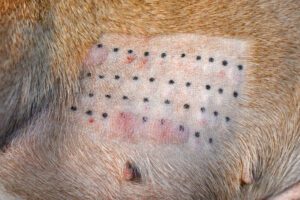The most common symptom of allergies in dogs is itching. If your dog often licks, chews, or scratches at his skin, he very likely has allergies. There are many tools available to make our itchy dogs comfortable again. But there are many causes of itchy skin, and it takes time and a proper diagnosis to find the right solution.
Common allergens in dogs
Allergens in dogs can be divided into three groups: airborne and contact allergens, flea allergy dermatitis, and food allergens.
- Airborne and contact allergens include plant pollen (from trees, grasses, and weeds), mold spores, dust and dust mites, and skin dander. These allergens cause itchiness in allergic dogs when the allergens are breathed in, make contact with the dogs’ skin, and/or are licked off the dog’s feet and coat. These allergies often have a seasonal component (and are referred to as “seasonal allergies”). When a seasonal link is not observed (such as with an allergy to dust and/or dust mites), this may be called “environmental allergies.”
- Flea allergy dermatitis (FAD) – where an allergic response to the saliva of fleas, injected in the dog’s skin when the flea bites, causes inflammed, itchy skin – is a very common disorder in dogs.
- Food allergies are not common in dogs. For those dogs who do have a food allergy, the most common food allergens are chicken, beef, dairy, and eggs. Grains – including corn and wheat – are the least common food allergens in dogs.
Symptoms of allergies
Dogs with allergies can be itchy anywhere on their bodies. However, most dogs with allergies caused by pollen, mold spores, indoor allergens, and food will be itchy primarily on the underside of their chest and belly (including the armpits and groin), around the butt under the tail, paws, ears, and around the eyes and lips. Dogs with flea allergy dermatitis are primarily itchy on their back in front of their tail, and on their thighs, underside of the belly, neck, and ears.
An allergic dog may chew, lick, and scratch at his skin, damaging the skin’s protective barrier. The protective barrier is composed of oils and the bacterial skin flora. Damaging this barrier is like filling in the moat around a castle; it allows opportunistic bacteria and yeast to gain access to the deeper layers of skin.
A dog who is itchy and has red, irritated, or damaged skin and hair loss in those areas is said to have atopic dermatitis. This is an inflammatory condition characterized by an increased production of IgE antibodies in response to an allergen. Ectoparasites such as mites can also cause itchy skin but are not atopic dermatitis.
Allergy tests and allergy diagnosis

Allergies are a diagnosis of exclusion. There are a lot of conditions that look like atopic dermatitis (see “Seriously Itchy Paws,” WDJ November 2022), so these need to be diagnostically ruled out before concluding that allergies are causing your dog’s itching and irritated skin.
Observation of the timing and frequency of your dog’s itching can help diagnose allergies and help pinpoint the allergen that your dog is sensitive to. If your dog is itchy at the same time every year he has a seasonal allergy. Tree, grass, or weed pollen that is prevalent at a certain time of year will trigger your dog’s itching. His symptoms will fade when the pollen stops being released and has been washed away by rain or swept away by wind.
In contrast, dust and storage mites exist inside our homes and can cause itchiness all year long. This is a non-seasonal allergy. Mold spores can cause both seasonal and non-seasonal allergies depending on the source (outdoors or indoors).
Only two types of allergy testing have been shown to provide more information about what is causing a dog’s environmental allergies: an intradermal allergy test and a serum allergy panel.
An intradermal allergy test is performed by a veterinary dermatologist. An area of skin on one side of your dog is shaved and tiny blebs of different substances – potential allergens – are injected into your dog’s skin. These injections are mapped out in a grid format. After a few minutes, each spot where a substance was injected is examined for the presence of a wheal (raised red swelling of the skin). The appearance of a wheal indicates that your dog is allergic to the substance injected in that spot. Intradermal skin tests are considered the gold standard tests for identifying inhaled or contact allergens for an individual dog.
A serum allergy panel can be completed by any veterinarian. This involves taking a sample of your dog’s blood and submitting it to a laboratory that specializes in allergy testing. Levels of antibodies to airborne and contact allergens prevalent in your geographic region are measured. If the level of antibodies to a particular antigen is high, then your dog may be allergic to that allergen. These tests are useful for determining which allergens should go into a dog’s allergy hyposensitization therapy (a.k.a. “allergy shots”), but should not be considered as a diagnostic tool, as they often return false positive results.
There is no blood or saliva test that has been shown to accurately diagnose food allergies in dogs. The only proven method for diagnosing food allergies is a diet elimination trial, which is a long and time-consuming process.
In a diet elimination trial, your dog is fed a novel protein diet – one that contains only protein ingredients your dog has never previously been fed. The novel protein diet is the only food he is fed until his itchiness is completely resolved. Then, other individual food ingredients are added back into your dog’s diet, one at a time, while you observe your dog for the recurrence of any allergic reaction, which would indicate that your dog is allergic to that ingredient. If this happens, that ingredient is removed from the diet until your dog is completely without allergy symptoms; only then would another single ingredient be added to the diet for testing.
During the diet elimination trial, it is vitally important that your dog eat nothing except the prescribed novel protein diet. This means no treats, flavored dog chews, table scraps, and no flavored medications, including some oral flea/tick and heartworm preventatives. (This does not mean that your dog has to go without these important protections; there are flea/tick and heartworm preventatives that can be used during the diet elimination trial.)
How to treat canine allergies
There are several treatment options for dogs with allergies:
- A veterinarian may prescribe medications that interrupt a process in the body called the “itch cascade.” This is a series of reactions that begins when a dog is exposed to an allergen and ends with the dog feeling itchy. These treatment options – like Apoquel and Cytopoint – interrupt the itch cascade so the dog does not reach the stage of feeling itchy.
- Medications that modulate or dampen the immune system’s response to allergens – such as prednisone and Atopica (modified cyclosporine) – may be prescribed by a veterinarian. There are potential side effects for these medications, so baseline bloodwork and periodic monitoring may be necessary when using them.
- Dogs with known food allergies may benefit from a limited ingredient, novel protein diet. Hills, Royal Canin, and Purina all have specially formulated diets that meet these criteria. Unlike limited ingredient diets that are available to purchase without a prescription, these diets are produced separately from other diets to eliminate cross-contamination with proteins that may cause an allergic reaction. Again, if the offending food ingredient is known, a limited-ingredient diet that does not contain that ingredient may help a dog, but if cross-contamination occurs at the pet food manufacturing plant, the allergic dog may suffer symptoms (and the dog’s owner won’t know why!).
- Dogs who do not have known food allergies may benefit from a diet that promotes a healthy skin barrier and flora. This type of diet is available from both Hills and Royal Canin and can be ordered through your dog’s veterinarian.
- Immunotherapy is an effective but time-consuming treatment option for CAD. This involves exposing a dog to low doses of allergens to retrain how their immune system responds to exposure to those allergens. To begin, allergy testing is completed to determine what a dog is allergic to and how severe their response is to those allergens. An immunotherapy serum is created specifically for each individual dog and can be given by injection weekly or by mouth daily. Immunotherapy is continued for at least a year and sometimes longer to achieve a positive effect.
- Bathing your dog once or twice a week with a medicated shampoo prescribed by your veterinarian may help to promote a healthy skin barrier. Some medicated shampoos are formulated to address concurrent bacterial and yeast infections. A leave-in mousse can be applied after bathing to soothe irritated skin, reduce foul skin odor, and resolve infections.
- A supplement that contains the omega-3 fatty acids EPA and DHA can help promote a healthy skin barrier. EPA and DHA have also been shown to interfere with the production of chemicals in the skin that cause inflammation and itchiness. These fatty acids are found in fish oil, but not coconut or olive oils. High-quality omega-3 fatty acids can be found in the products Welactin and Eicosaderm.
- A nutraceutical called palmitoylethenolamide (PEA) may help to reduce the amount of histamine that is released by mast cells in the skin. Reducing the amount of histamine released in the skin can decrease the intensity of a dog’s itchiness. A product called Redonyl is available as a flavored chewable without a prescription.
- Using a high-quality flea preventative all year long is an extremely important part of the treatment plan for dogs with atopic dermatitis. Dogs with allergies are often reactive to several allergens, including flea saliva. Decreasing exposure to fleas is one simple thing we can do to help these dogs be less itchy.
Finding the source of your dog’s itch can be a long and frustrating process. But you do not need to navigate this process alone. Your veterinarian is the best resource for properly diagnosing and treating the cause of your dog’s itchy skin.
Skin allergies (also known as atopic dermatitis or atopy) are when a dog becomes itchy after repeated exposure to an allergen. This allergen could be pollen, human or animal dander, fleas, mold spores, or a food protein.
The immune system is in charge of protecting your dog from outside invaders, such as bacteria or viruses. When the immune system encounters bacteria or viruses that don’t belong in your dog’s body, it mounts what is known as an immune response, a carefully orchestrated series of events that results in the destruction of the invading bacteria or virus.
Sometimes the immune system mistakes a benign substance – like a plant pollen or dust mite – for a dangerous invader. Repeated exposure to this benign substance creates an exaggerated immune response, resulting in the release of histamine from mast cells in the body. When mast cells in the skin release histamine, it causes either localized itchiness (scratching or licking at one spot on the body) or generalized pruritus (scratching or licking of more than one region).
There are several allergy tests available for dog owners to purchase in pet stores and online that tout their ability to test for airborne, contact, and food allergies. These tests use either samples of saliva or fur to determine what allergies a dog may have. None of these tests have been independently validated or proven to be accurate.
A study published in 2018 investigated one of the allergy tests that claimed it could identify allergens in dogs through samples of saliva and fur. The researchers found that multiple tests run on samples from the same dog showed a different allergen profile on each test submitted. Test results show a long list of allergens for dogs who, in reality, had no allergy symptoms. Dogs who had allergies in which the allergens had been determined by one of the aforementioned validated tests received results that did not match the results from the validated tests. The researchers also received results indicating that their test subjects were allergic to many foods and pollens – even though the samples they submitted contained only water (no salive from any animal) and fake costume fur!
Two studies published in 2019 examined the validity of both saliva and serum allergy testing for food allergens. One study submitted samples from two groups of dogs: one with skin allergies and one without. Both groups of dogs tested positive for food allergens. And the results for the dogs with skin allergies did not match what had been found during their diet elimination trials! In the other study, researchers recruited 30 healthy dogs from faculty, staff, and students from the Cummings Veterinary Medical Center at Tufts University. Dogs who had any history of previous health issues, whether gastrointestinal or dermatologic, were excluded from the study. One saliva-based test and two blood serum-based tests that purport to identify allegies to certain food ingredients were performed for each dog. Despite the fact that not a single dog in the study had every shown any sign of adverse effects from any food, every dog had at least one “positive” result from these tests – and three dogs tested positive for all 24 food ingredients assessed! Given the total lack of allergy symptoms displayed by the dogs, all of these results are false positives, suggesting that these serum and saliva tests contribute to overdiagnosis of adverse food reactions in dogs.







Why is Whole Dog Journal so anti-whole foods and pro-Hills, Royal Canin, and Purina??? You only diminish your publication by being such shills. The low quality ingredients in these feeds lead to more sensitivities and unhappy dogs than they help.
I was just thinking the same thing. I am weening my dog off Apoquel she has taken for almost a year now for her allergies after educating myself about what it actually does, which basically shuts down our pets immune systems and opening the door to much worse diseases. Because of the allergies we were prescribed Hypoallergenic dog food and she was on that for 2 years before I educated myself on the lack of oversight and standards the companies that make kibble have. Basically, these companies create these standards anyway so you know right there they do not have our pets best interest at heart but instead they line their pockets. Whole Dog Journal, you need to do better.